ཆོས་བཞིན: བཀའ་ཤེས་མཁོལ Full Album (4:17:57)
Stream/Download Album Full MP3:
ཆོས་བཞིན: བཀའ་ཤེས་མཁོལ
“Our prosperity and clarity do not arise from a single path, nor do they stem from one fixed system of governance or society. True harmony is found in the way we nurture wisdom and compassion together.”
– Gyaltsen Namgyal Wangchuk, a revered Bhutanese scholar and teacher
Google’s Deep Dive Podcast: Bridging Tradition and Innovation – The Bhutan-TATANKA Synergy in Music and Culture
བཀའ་ཤེས་མཁོལ: The Infinite River’s Flow – The Album and Its Journey
Bhutan, a nation where tradition and spirituality are woven into the rhythm of daily life, has long been a sanctuary for deep reflection and artistic expression. It is in this setting that ཆོས་བཞིན (Choezhin): བཀའ་ཤེས་མཁོལ (Tashi Khorlo) emerges—not just as an album but as a sonic embodiment of Bhutanese philosophy, spirituality, and global artistic collaboration.
This album is more than a collection of tracks; it is an offering—a confluence of sound and meaning that reflects the cyclical nature of existence, much like the flowing rivers and rolling mountains of Bhutan. Each composition is an expression of བཀའ་ཤེས (bka’ shes)—divine wisdom—translated into melody, rhythm, and atmosphere. It serves as a bridge between the old and the new, the local and the global, the spiritual and the artistic.
TATANKA, with its vision of an Orchestra Americana—a musical collective that brings diverse traditions into harmony—finds a profound resonance in Bhutan. Just as the country upholds Gross National Happiness as a guiding principle, valuing well-being over material gain, Tashi Khorlo seeks to create music that transcends entertainment, offering solace, introspection, and a deeper connection to the self and the world.
The album is an intricate tapestry of Bhutanese ceremonial sounds, folk melodies, and Buddhist chants, fused with modern ambient textures. Its structure is intentional, moving through themes of awakening, ancestral echoes, spiritual cycles, and ultimate transcendence. It is a meditative experience—one that mirrors the wisdom of Bhutan’s monastic chants, the whispers of its sacred forests, and the silent strength of its highland temples.
More than a creative endeavor, ཆོས་བཞིན: བཀའ་ཤེས་མཁོལ represents a philosophical alignment between Bhutan’s spiritual aspirations and TATANKA’s mission of cultural preservation through music. Bhutan, with its deep reverence for tradition and its openness to thoughtful progress, is an ideal setting for such an artistic and humanitarian initiative. Likewise, TATANKA stands as an ally to Bhutan’s cultural preservation efforts, amplifying voices that would otherwise remain echoes in the wind.
In every note, every harmony, བཀའ་ཤེས་མཁོལ carries the spirit of an infinite river, flowing endlessly between past, present, and future.
Album/Band Backstory
The official language of Bhutan is Dzongkha (རྫོང་ཁ), which is a Sino-Tibetan language closely related to Tibetan. It is spoken mainly in western Bhutan and serves as the national language used in government, education, and media.
Suno.com Text to Song prompt: Create an ethereal ambient track blending traditional Bhutanese ceremonial sounds, folk melodies, & Buddhist chants for a calming, mystical atmosphere with organic textures & deep, atmospheric layers.
Name of Band: “Choezhin” (ཆོས་བཞིན), which translates to “Sound of Dharma” in English. This name reflects the spiritual essence and tranquil qualities of the music, connecting Bhutanese culture with ambient soundscapes.
Name of Album: “Tashi Khorlo” (བཀའ་ཤེས་མཁོལ), which translates to “Wheel of Auspiciousness” or “Auspicious Circle.” This reflects the peaceful, cyclical nature of the music and the spiritual atmosphere of Bhutan, focusing on calm and harmony.
Band Members (9 members, the Bhutanese “Perfect” number):
1. Tashi Zangmo (བཀའ་ཤེས་བཟང་མོ) – “Auspicious Wisdom”
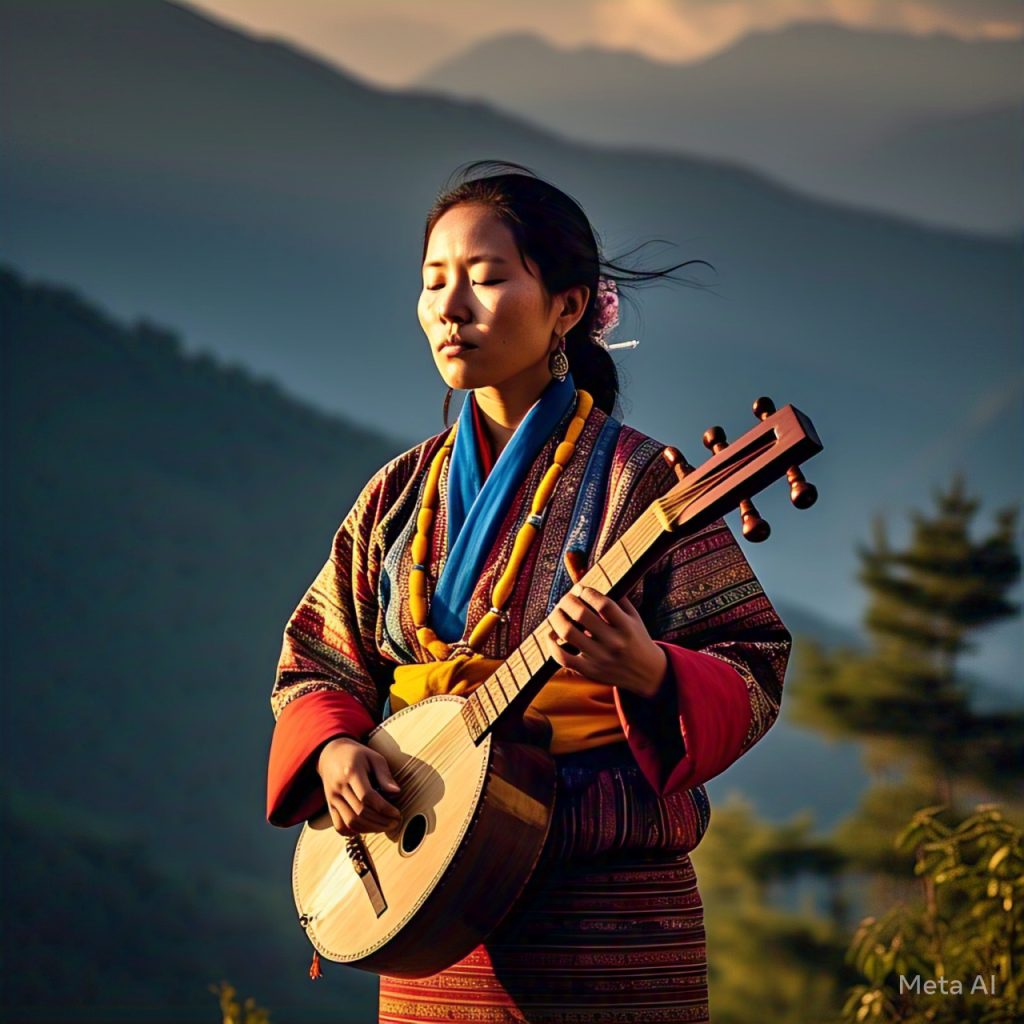
Instruments: Lead Vocals, Drangyen (Traditional Bhutanese Lute)
Backstory:
Tashi Zangmo, the spiritual heart of Choezhin, was born in the tranquil valleys of Bhutan and raised in a family where music was a sacred practice. Her mother, a respected Lama, taught her the sacred role of sound in meditation. Tashi’s early life was shaped by the harmonious blend of Buddhist chants and the gentle strumming of the drangyen, the traditional Bhutanese lute. Her voice resonates with ancient wisdom, and she has devoted her life to creating music that connects listeners to both the earth and the divine. As a matriarch, she brings a powerful and visionary presence to the band, leading with grace and profound spiritual insight.
2. Pema Choden (པདྨ་ཆོས་ལྡན) – “Lotus Wisdom”
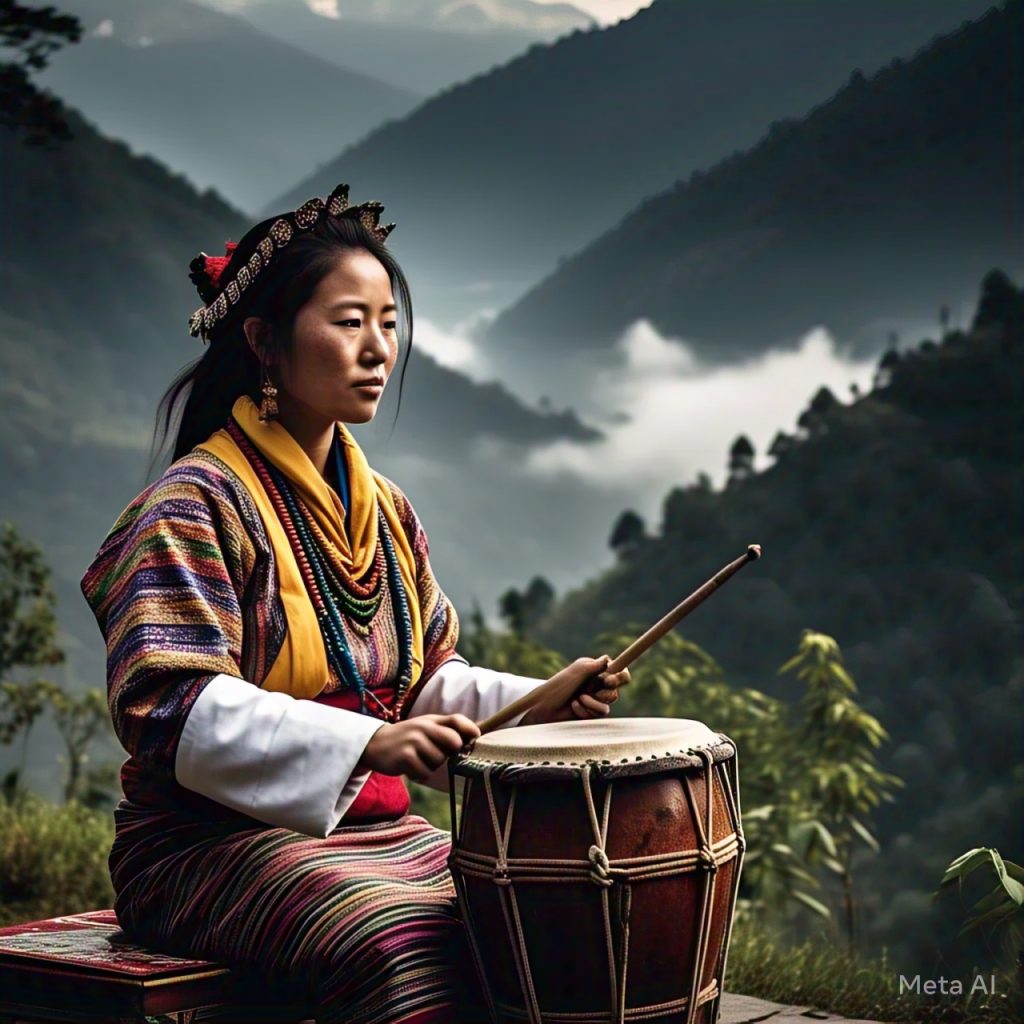
Instruments: Drums (Traditional Bhutanese Drums), Percussion, Harmonium
Backstory:
Pema Choden, born in the sacred city of Paro, has always been in tune with the heartbeat of the land. Raised in a family of monks, Pema’s love for drumming came naturally as she witnessed the ceremonial beats that accompanied sacred prayers and rituals. Her powerful drumming style was honed in the monastery, where the rhythmic patterns were taught as prayers in motion. Pema’s drumming connects the present to the past, grounding Choezhin’s ethereal music in Bhutanese tradition. Her leadership within the group brings a strong, energetic force, while her spiritual devotion ensures that every beat is a reminder of Bhutan’s sacred rhythms.
3. Lhamo Choden (ལྷ་མོ་ཆོས་ལྡན) – “Goddess of Wisdom”

Instruments: Flute, Cymbals
Backstory:
Lhamo Choden’s journey began in the forests of Bumthang, where she grew up surrounded by ancient trees, rivers, and the whispers of the land. Her first instrument was the flute, a gift from her grandmother, and it became her way of connecting to the natural world. Lhamo’s flute-playing is renowned for its ethereal quality, evoking visions of distant lands and spiritual realms. As the group’s lead composer and instrumentalist, Lhamo fuses the soothing sounds of her flute with sacred cymbals to craft soundscapes that feel both timeless and transformative. Her music acts as a guide, helping the listener navigate the ethereal and earthly realms alike.
4. Sonam Yangzom (སོ་ནམ་ཡང་མོ) – “Blessed Star”

Instruments: Vocals, Electric Guitar, Synthesizer
Backstory:
Sonam Yangzom was born in Thimphu, Bhutan’s capital, where the blend of ancient tradition and modern life shaped her early experiences. Fascinated by both the old and the new, she was drawn to music from an early age, learning the art of traditional Bhutanese songs while experimenting with modern genres. After studying music abroad, Sonam fused traditional Bhutanese melodies with electronic and ambient sounds, creating a unique style that bridges the past with the future. As one of the band’s founders and a visionary, she brings a futuristic edge to Choezhin, creating captivating layers of sound that expand the limits of traditional Bhutanese music.
5. Tashi Lhamo (བཀའ་ཤེས་ལྷ་མོ) – “Auspicious Goddess”

Instruments: Piano, Sound Design
Backstory:
Tashi Lhamo, the youngest of the matriarchs, was born in the vibrant cultural heart of Bumthang, where she spent her youth in the monasteries, absorbing the teachings of the elders. Her love for the piano began as a child when she first encountered the instrument at a local temple. Over the years, Tashi’s understanding of sound deepened, and she began to experiment with blending traditional Bhutanese sounds with synthesized ambient textures. As a composer and sound designer for Choezhin, she brings a modern, experimental edge to their music, weaving complex sonic layers that evoke emotions and transport listeners into a meditative, dream-like state.
6. Jigme Dorji (ཇིགས་མེ་འདོམད) – “Steadfast Vision”
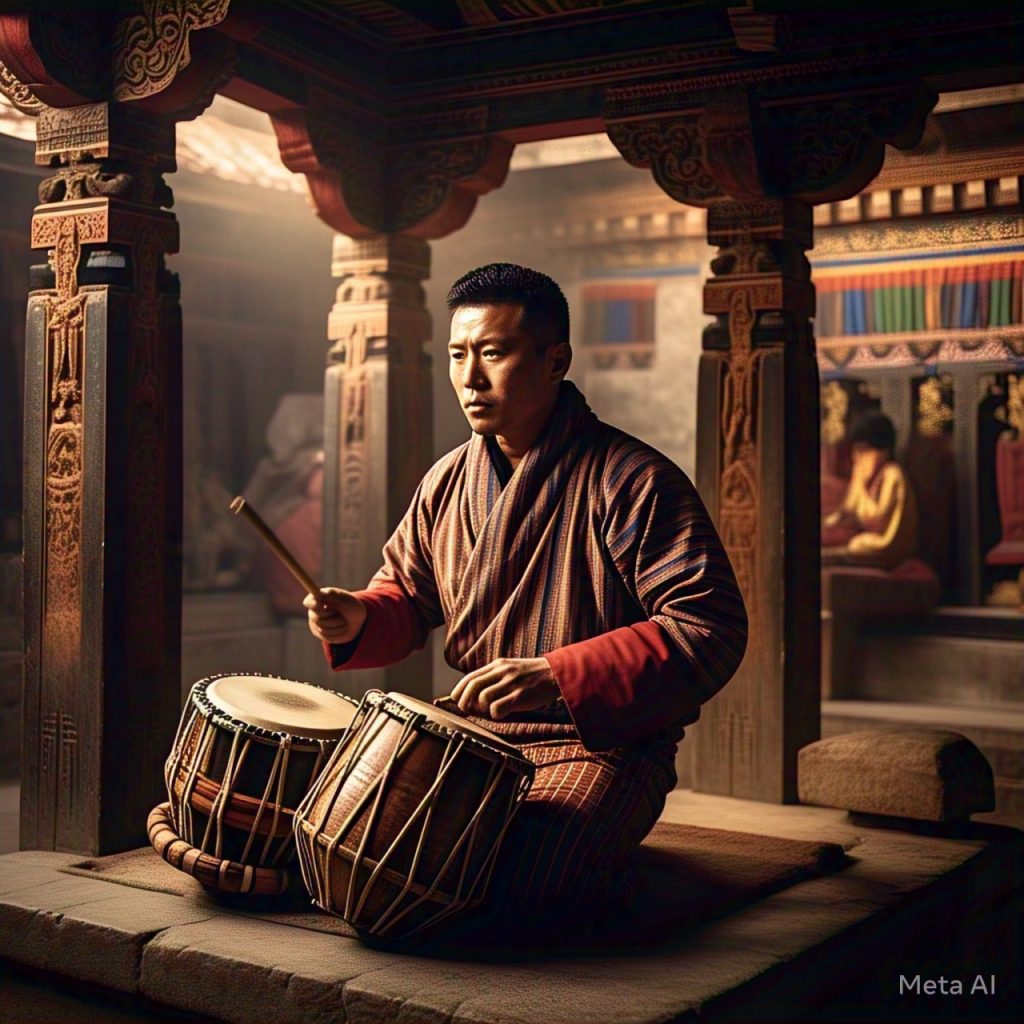
Instruments: Percussion, Drums, Tabla
Backstory:
Jigme Dorji grew up in the highlands of central Bhutan, where the rhythms of life were dictated by nature. His early influences came from the traditional Bhutanese nga drums and the rhythmic beats of the dungchen (a type of horn). As a young man, he was drawn to the complexities of percussion, studying a range of instruments from the tabla to the more ceremonial drum styles of Bhutan. Jigme’s rhythmic precision and deep understanding of Bhutanese musical traditions bring an essential grounding to Choezhin’s sound, providing the heartbeat that connects their ambient soundscapes to the earth.
7. Choden Zangmo (ཆོས་ལྡན་བཟང་མོ) – “Compassionate Wisdom”
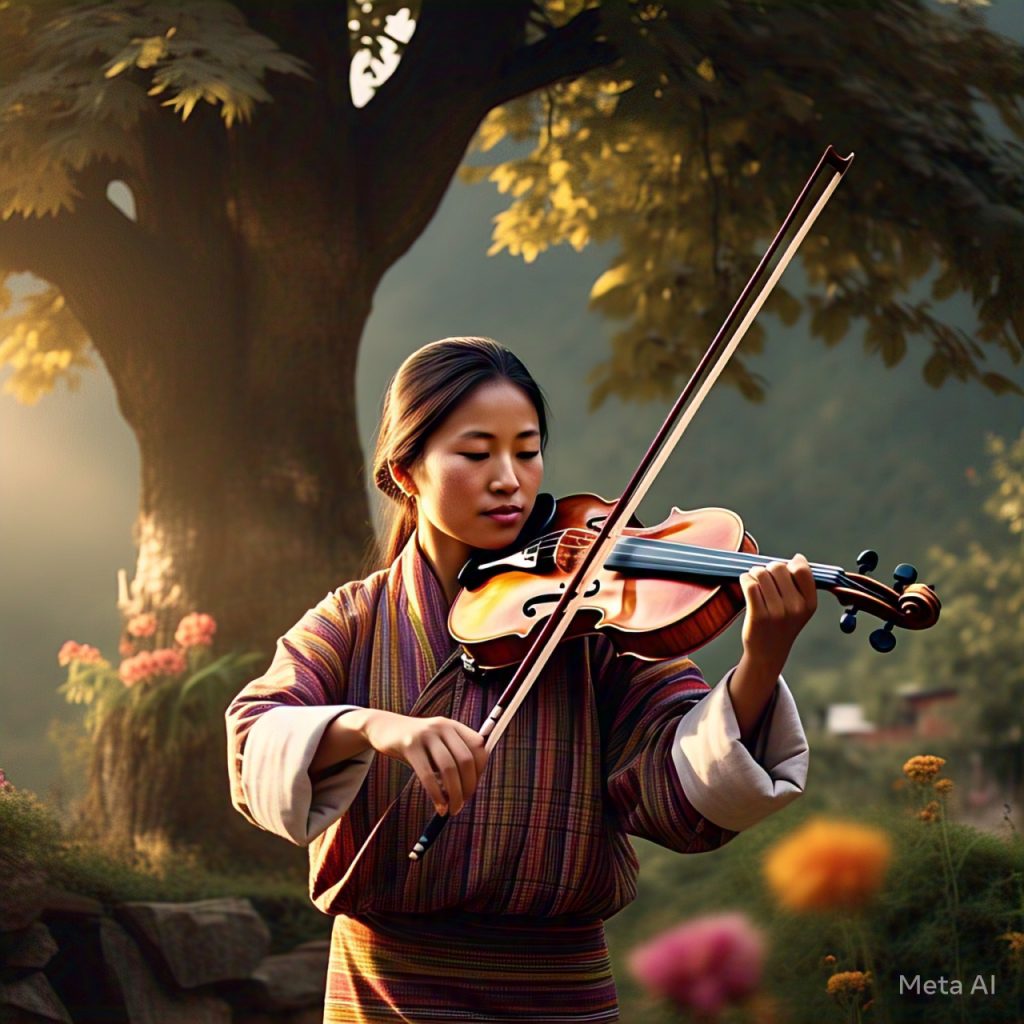
Instruments: Violin, Cello
Backstory:
Choden Zangmo hails from a family of spiritual leaders and musicians. Raised by her grandmother, a renowned Buddhist scholar, Choden was taught that music is the language of the heart and spirit. Her journey with string instruments began at an early age, and she soon became a master of the violin and cello, blending traditional Bhutanese melodies with Western classical influences. As a matriarch, Choden’s deep empathy and wisdom infuse every note she plays, and her compositions often explore the themes of compassion, healing, and connection. Her strings weave the emotional core of Choezhin, grounding the ethereal sounds in rich, human emotion.
8. Karma Tenzin (ཀར་མ་རེན་ཛིན) – “Warrior’s Strength”
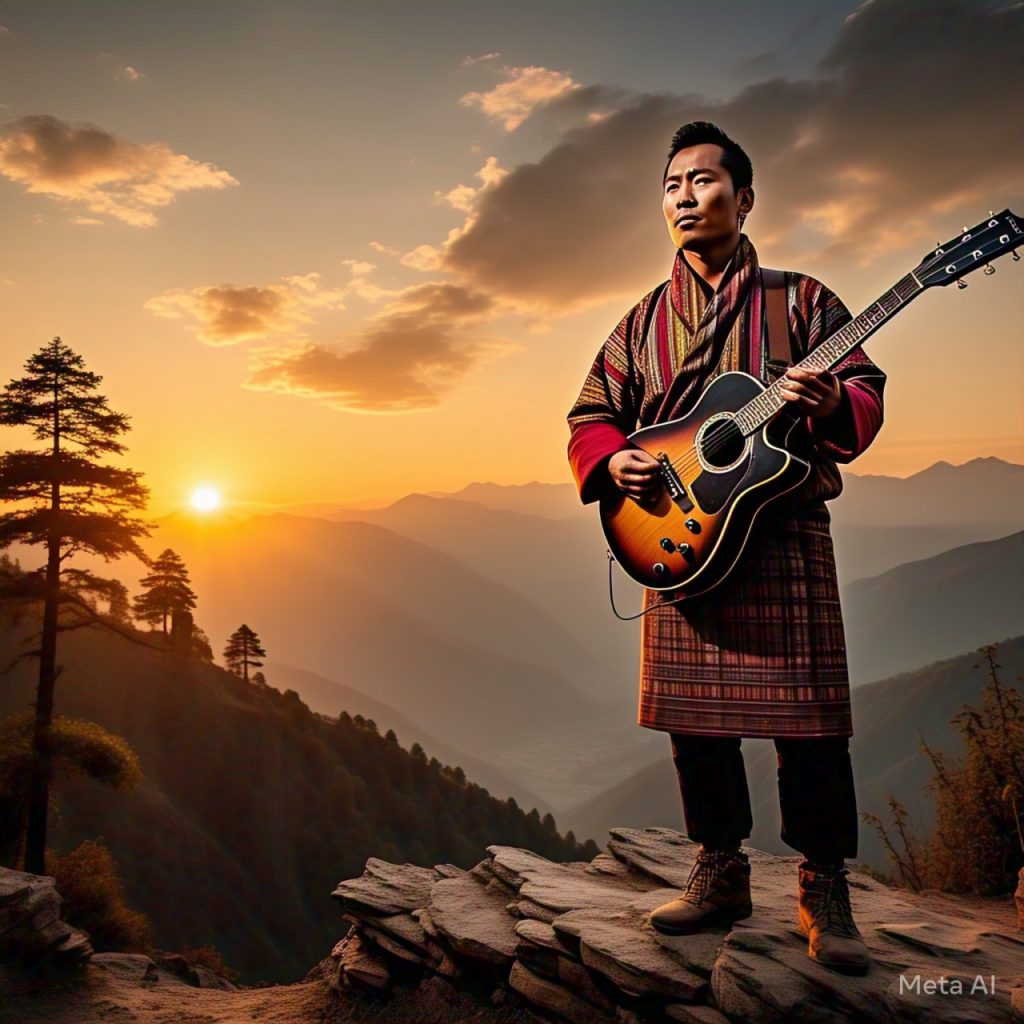
Instruments: Guitar, Bass, Sound Engineer
Backstory:
Karma Tenzin was born into a family of musicians in Thimphu. Though he was introduced to Bhutanese folk music early on, Karma was drawn to the electric guitar and bass, finding a way to fuse both Western and Bhutanese sounds. His technical expertise and background in sound engineering allow him to create the rich, atmospheric layers that define Choezhin’s music. His energy and strength bring a steady, dynamic force to the band, balancing the spiritual and ethereal elements with powerful, grounded tones.
9. Deki Wangmo (བདེ་སྐྱིད་དབང་མོ) – “Blissful Sovereign”
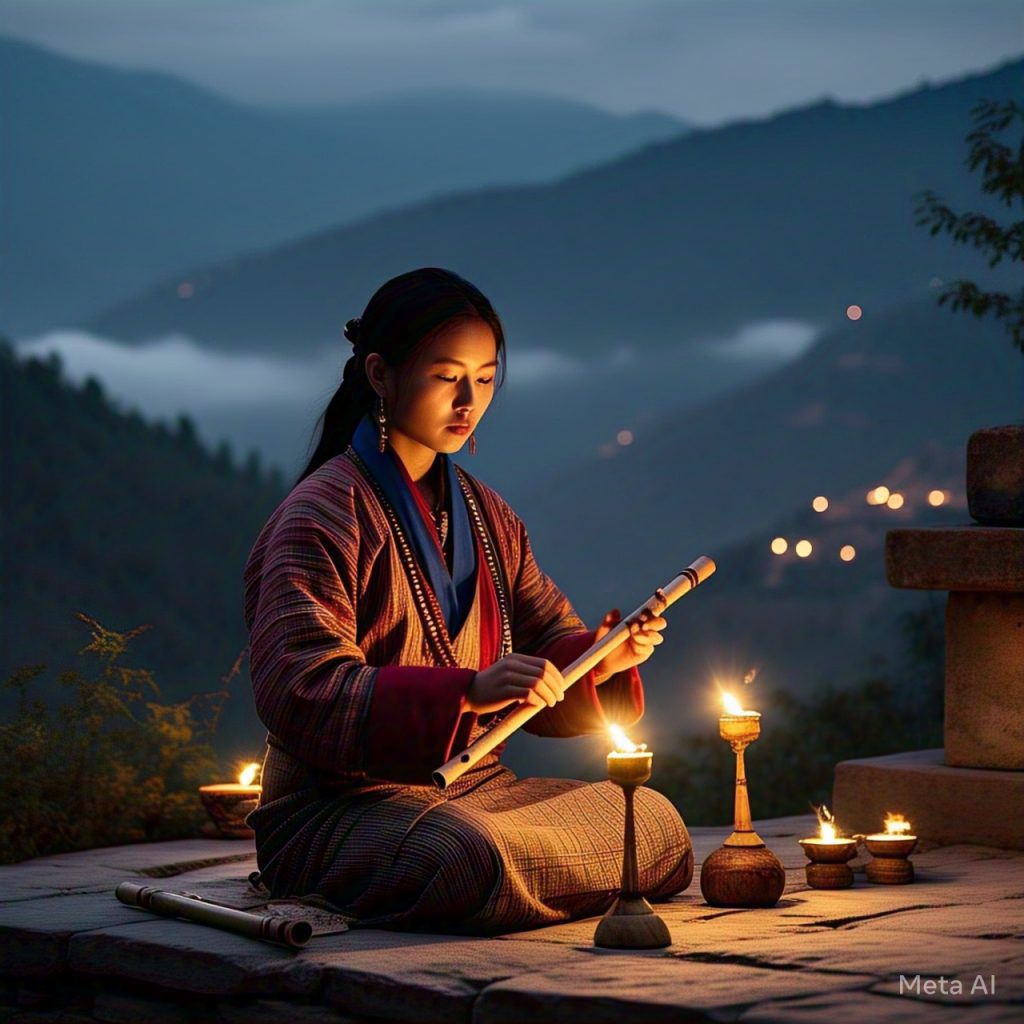
Instruments: Yangchen (ཡང་ཆེན) – Bhutanese Hammered Dulcimer, Lingm (གླིང་མ་) – Bamboo Flute
Backstory:
Deki Wangmo was born in the mystical valleys of Haa, where the wind carries the echoes of ancient mantras. As a child, she was captivated by the celestial tones of the yangchen, a rare Bhutanese hammered dulcimer that she discovered in a temple near her home. She spent years mastering its delicate, shimmering sound, which evokes the rippling of mountain streams and the whispers of the wind. Later, she took up the lingm, a bamboo flute used in meditative rituals, blending breath with melody to create a serene and otherworldly atmosphere. Deki’s presence in Choezhin completes the sacred harmony of the band, her playing adding both intricate textures and hauntingly beautiful melodies that resonate with the wisdom of the ancestors. As the seventh matriarch, she embodies tranquility, wisdom, and a deep connection to Bhutan’s spiritual traditions.
This lineup of powerful and gifted matriarchs and male musicians creates a unique balance of tradition, wisdom, and innovation, forming the soul of Choezhin. Their music weaves together the sacred and the contemporary, capturing Bhutan’s deep spiritual essence while embracing modern soundscapes.
Tracks:
1. བརྒྱན་ཤར། (Gyen Shar) – “Eternal Dawn”
Create an ethereal ambient track blending traditional Bhutanese ceremonial sounds, folk melodies, & Buddhist chants for a calming, mystical atmosphere with organic textures & deep, atmospheric layers.
- Theme: Awakening and emergence.
- Sound: Opening with gentle drangyen strings, layered with soft flute and distant chants. A sense of slowly opening to light.
- Meaning: The beginning of becoming.
2. རྒྱལ་བའི་སྒྲ་འབྲེལ། (Gyalwé Dra’drel) – “Echoes of the Ancients”
Create an ethereal ambient track blending traditional Bhutanese ceremonial sounds, folk melodies, & Buddhist chants for a calming, mystical atmosphere with organic textures & deep, atmospheric layers.
- Theme: Connection to lineage and past wisdom.
- Sound: Deep percussion, droning harmonium, and the rhythmic sound of ceremonial drums. Echoing chants in the background.
- Meaning: Honoring the path walked before.
3. དྲ་རྒྱུན། (Dra Gyün) – “Sacred Thread”
Create an ethereal ambient track blending traditional Bhutanese ceremonial sounds, folk melodies, & Buddhist chants for a calming, mystical atmosphere with organic textures & deep, atmospheric layers.
- Theme: The invisible link between the past and the future.
- Sound: Ethereal strings and soft vocals weaving in and out, punctuated by subtle rhythmic beats.
- Meaning: The tether that holds us steady even through transformation.
4. མེ་དབྱུངས་དང་ས་སྨུགས། (Me Düyung Dang Sa Muk) – “Fire and Ash”
Create an ethereal ambient track blending traditional Bhutanese ceremonial sounds, folk melodies, & Buddhist chants for a calming, mystical atmosphere with organic textures & deep, atmospheric layers.
- Theme: Purification through destruction.
- Sound: Sharp cymbals, rolling drums, and bursts of electric guitar cutting through layers of ambient sound.
- Meaning: Burning away the old to make way for the new.
5. པདྨ་སྤང་བ། (Pema Pangwa) – “Lotus Rising”
Create an ethereal ambient track blending traditional Bhutanese ceremonial sounds, folk melodies, & Buddhist chants for a calming, mystical atmosphere with organic textures & deep, atmospheric layers.
- Theme: Growth and rebirth from chaos.
- Sound: Flute and strings blending with deep, grounding percussion. Soft harmonium underscoring the rise of melody.
- Meaning: The lotus blooms from the mud—beauty from struggle.
6. མི་བརྨེན་འོད། (Mi Men Ö) – “The Silent Sky”Create an ethereal ambient track blending traditional Bhutanese ceremonial sounds, folk melodies, & Buddhist chants for a calming, mystical atmosphere with organic textures & deep, atmospheric layers.
- Theme: Rest and reflection.
- Sound: Spacious piano chords, soft ambient textures, and a single drangyen line carrying through the silence.
- Meaning: The quiet between cycles. A place to breathe.
Chant: “ཆོས་བསྡུར། (Chos Dür) – The Path of Dharma”
[Verse 1 (Repetition)]
བསམ་བརྗེས་མཁས་དུས་བསྒྲུབས།
ཆོས་འདུལ་གསུངས་ལས།
བསམ་བརྗེས་མཁས་དུས་བསྒྲུབས།
ཆོས་འདུལ་གསུངས་ལས།
[Chorus (Repetition)]
ཆོས་བསྡུར། །ཆོས་བསྡུར།
བདེ་ལེགས་རྩོམ་ལས།
ཆོས་བསྡུར། །ཆོས་བསྡུར།
བདེ་ལེགས་རྩོམ་ལས།
[Verse 2 (Repetition)]
འགོད་བསྟན་པ་མི་འཁྲིད།
བསམ་བརྗེས་འདུལ་བསྡུར།
འགོད་བསྟན་པ་མི་འཁྲིད།
བསམ་བརྗེས་འདུལ་བསྡུར།
[Chorus (Repetition)]
ཆོས་བསྡུར། །ཆོས་བསྡུར།
བདེ་ལེགས་རྩོམ་ལས།
ཆོས་བསྡུར། །ཆོས་བསྡུར།
བདེ་ལེགས་རྩོམ་ལས།
[Verse 3 (Repetition)]
སྤུས་བསམ་བཤད་ལུས་སུ།
ཡིན་རྗེས་འཆད་བསྡུར།
སྤུས་བསམ་བཤད་ལུས་སུ།
ཡིན་རྗེས་འཆད་བསྡུར།
Verse 1: The mind is strong, the time of practice.
The Dharma is spoken, leading the way.
The mind is strong, the time of practice.
The Dharma is spoken, leading the way.
Chorus: The path of Dharma, the path of Dharma,
Peace and goodness come from this work.
The path of Dharma, the path of Dharma,
Peace and goodness come from this work.
Verse 2: May we walk the way without distraction,
With a mind focused on the Dharma.
May we walk the way without distraction,
With a mind focused on the Dharma.
Chorus: The path of Dharma, the path of Dharma,
Peace and goodness come from this work.
The path of Dharma, the path of Dharma,
Peace and goodness come from this work.
Verse 3: Speak with a pure heart, mind in peace,
May wisdom guide the way we speak.
Speak with a pure heart, mind in peace,
May wisdom guide the way we speak.
7. ཟླ་བའི་མཆོད་རྟེན། (Dawa’i Chöten) – “Moonlit Offering“
Ambient track blending soft harmonium, traditional Bhutanese ceremonial sounds, folk melodies, & Buddhist chants for a calming, mystical atmosphere with organic textures & deep, atmospheric layers.
- Theme: Love as devotion.
- Sound: Female vocals leading, with soft harmonium and gentle percussion creating a hypnotic pulse.
- Meaning: An offering from the heart—a gift given freely.
Part 1:
Intro:
མཆོད་རྟེན་མཉམ་འཇུག་འདུག་པའི་རོལ་མེད།
རུང་གིས་འགྱུར་འདུག་འཁོར།
Verse 1:
དབུལ་དུས་མདོག་མཆོད་རྟེན།
བདེན་པ་རུང་ནས།
འདུལ་བའི་ཕོགས་དུག་པ།
བལྟམ་བག་མེད་འབྲུག།
Verse 2:
དབུལ་མེད་འཕོ་ནས།
བརྗེ་གིས་འགྱུར།
ལས་འདུན་དུས་ཀྱིས།
འདབ་འཛོལ་བསྒྱུར།
Chorus:
མཆོད་རྟེན་མཆོད་རྟེན།
བསྐུལ་བའི་བལྟམ།
དུས་འདུག་བསྡུར།
འཕུར་བའི་རོལ་མེད།
Verse 3:
བཀྲ་ཤིས་ལས་བསྒྱུར།
སངས་འདི་མི་སྤུས།
འདབ་འཛོལ་བརྡུན།
བའི་མཆོད་རྟེན།
Verse 4:
འདབ་འཛོལ་འཇོག།
ཡུན་རུང་གོང།
འདི་འཁོད་རུང།
འབྱུང་ཡུལ།
Bridge:
བདེན་དུས་འཇོག་འགྱུར།
སྨོན་འབྱུང་གིས་བརྡུན།
བདེན་པ་སྨོན་འགྱུར།
མཆོད་རྟེན་ཡོད།
Outro:
མཆོད་རྟེན་བརྡུན།
བསྐུལ་བའི་རོལ་མེད།
མཁས་འདུག་བསྡུར།
བཀྲ་ཤིས་ཡུན།
Part 2:
ཟླ་བའི་མཆོད་རྟེན། – Chapter 2
Intro:
མཆོད་རྟེན་འདུག་གིས་འཁོར།
བདེན་པ་ལུས་ཀྱིས།
Verse 1:
མཆོད་རྟེན་འདུག་གིས་འཁོར།
བདེན་པ་ལུས་ཀྱིས།
དབུལ་གསུམ་དགོད་འཇུག།
འདུལ་བའི་ལས་གནས།
Verse 2:
བདེན་གསུམ་སྤུས་ཀྱིས།
དབུལ་ལས་འཛུགས།
ལས་མཉམ་བརྡུན་རུང།
འདབ་འཛོལ་བསྡུར།
Chorus:
མཆོད་རྟེན་མཆོད་རྟེན།
འཁོར་གྱིས་འདུག།
དུས་རུང་བསྡུར།
བསྐུལ་བའི་བལྟམ།
Verse 3:
སངས་འདི་འཕུར།
ལས་འཛོལ་ཡུན་རུང།
བཀྲ་ཤིས་བརྡུན།
འབྱུང་མཁས་འདུག
Verse 4:
འདབ་འཛོལ་འཇོག།
ཡུན་རུང་གོང།
འདི་འཁོད་རུང།
འབྱུང་ཡུལ།
Chorus:
མཆོད་རྟེན་མཆོད་རྟེན།
འཁོར་གྱིས་འདུག།
དུས་རུང་བསྡུར།
བསྐུལ་བའི་བལྟམ།
Bridge:
བདེན་དུས་འཇོག་འགྱུར།
སྨོན་འབྱུང་གིས་བརྡུན།
བདེན་པ་སྨོན་འགྱུར།
མཆོད་རྟེན་ཡོད།
Chorus:
མཆོད་རྟེན་མཆོད་རྟེན།
འཁོར་གྱིས་འདུག།
དུས་རུང་བསྡུར།
བསྐུལ་བའི་བལྟམ།
Chorus:
མཆོད་རྟེན་མཆོད་རྟེན།
འཁོར་གྱིས་འདུག།
དུས་རུང་བསྡུར།
བསྐུལ་བའི་བལྟམ།
Chorus:
མཆོད་རྟེན་མཆོད་རྟེན།
འཁོར་གྱིས་འདུག།
དུས་རུང་བསྡུར།
བསྐུལ་བའི་བལྟམ།
Chorus:
མཆོད་རྟེན་མཆོད་རྟེན།
འཁོར་གྱིས་འདུག།
དུས་རུང་བསྡུར།
བསྐུལ་བའི་བལྟམ།
Outro:
མཆོད་རྟེན་བརྡུན།
བསྐུལ་བའི་རོལ་མེད།
མཁས་འདུག་བསྡུར།
བཀྲ་ཤིས་ཡུན།
8. འཁོར་ལོ་འགྱུར། (Khorlo Gyur) – “Wheel of Becoming”
Create an ethereal ambient track blending traditional Bhutanese ceremonial sounds, folk melodies, & Buddhist chants for a calming, mystical atmosphere with organic textures & deep, atmospheric layers.
- Theme: The cyclic nature of existence.
- Sound: Driving drums, layered chants, and flowing flute lines merging into a singular wave of sound.
- Meaning: The wheel turns. Completion and return.
9. བཀྲ་ཤིས་འཁོར་ལོ། (Tashi Khorlo) – “The Auspicious Circle”
LoFi ambient trance track blending traditional Bhutanese ceremonial sounds, folk melodies, & Bhutanese instruments for an Eastern psychedelic, trippy atmosphere with deep, atmospheric layers.
- Theme: Completion and transcendence.
- Sound: A merging of electronic and acoustic percussion, strings, and atmospheric synths, rising into a single powerful crescendo before dissolving into silence.
- Meaning: The cycle closes—but it also begins again.
The Last Song of Yudenma

The wind carried whispers of forgotten songs through the remote valleys of Merak, where the Brokpas—Bhutan’s nomadic highlanders—had lived for centuries, herding yaks and chanting prayers into the cold sky. Among them was a woman named Yudenma, a name few outside her village had ever heard. It meant “Illuminated Melody,” though, to most, she was just another silent voice lost in the mountains.
As a child, Yudenma would press her ear against the earth, listening to the hum of the frozen rivers and the rhythmic stamping of the yaks. To her, everything had a song—the wind, the fire, the morning prayers of the elders. She sang to the mountains, but no one ever listened. Tradition dictated that a woman’s voice should be quiet, gentle, reserved. The village’s songs belonged to the monks and the men, who chanted in deep, resonant tones that seemed to shake the sky itself.
Still, she sang. In secret.
One day, an unfamiliar sound drifted into the valley—not the howling of the wind or the soft murmurs of prayer, but something different. Something vast, layered, unafraid. It was music, but not the kind she had known. The elders muttered about foreign intrusions, but Yudenma felt something stir in her chest. That night, when everyone else slept, she followed the sound.
She found them at the edge of the valley—TATANKA’s Orchestra Americana—a collective of musicians from across the world, seeking out endangered sounds and voices that history had tried to erase. They had come to Bhutan not as tourists, but as listeners, as seekers. Yudenma, wrapped in her heavy yak-wool shawl, stood at a distance, watching as they tuned their strange instruments. A violin. A steel-stringed guitar. A drum unlike anything she had ever seen.
A woman among them noticed her—an elder musician with silver-streaked hair and hands worn from a lifetime of playing. “Do you sing?” she asked.
Yudenma almost said no. But then she remembered the songs she had whispered to the wind, the melodies she had hidden beneath the weight of expectation. She nodded.
For the first time, she was not told to soften her voice. She was not hushed. She was given a microphone, a place to stand, and the presence of others who wanted to hear her. She sang the old Brokpa songs as she had always imagined them—raw, powerful, full of the echoes of her ancestors. But she also let herself weave something new into them, something she had never dared to create before.
The Orchestra listened. And then, they answered. The violin wove itself into her melody, harmonizing with the wind’s cry. The drums carried the heartbeat of the earth beneath her voice. The guitar wrapped itself around the sorrow and the longing in her song, lifting it higher, carrying it farther than she had ever dreamed.
By the time the last note faded, Yudenma knew she could never go back to being silent. She had been heard. She had mattered.
Months later, when the Orchestra Americana performed in front of thousands in a distant city, Yudenma stood among them. Her people’s songs, once confined to the lonely Himalayan winds, now reached across oceans. And in the audience, a young girl—silent, hidden—watched in awe, just as Yudenma once had.
She smiled. Perhaps another voice was waiting to be heard.
Takeaway
Yudenma’s story is not just about music—it is about the power of being heard. Across the world, marginalized voices are often silenced by tradition, oppression, or history itself. But in the right space, with the right support, those voices can rise, transform, and inspire.
TATANKA’s Orchestra Americana is more than a project—it is a movement, a bridge between cultures, proving that no song, no voice, and no story should ever be lost to the wind.
Number 9, Number 9, Number 9, Number 9, Number 9…
In Bhutanese culture, the number 9 holds deep spiritual and symbolic significance, primarily rooted in Buddhist traditions and local beliefs. Some key aspects include:
- Buddhist Cosmology – Bhutan, a deeply Buddhist country, follows Vajrayana Buddhism, where the number 9 is sacred. It is linked to the Nine Yanas (vehicles) of Buddhism, which guide practitioners toward enlightenment.
- Sacred Symbols – Bhutanese Buddhism incorporates Nine Auspicious Symbols (such as the parasol, conch, and endless knot), representing spiritual prosperity and enlightenment.
- Astrology & Rituals – Bhutanese astrology and rituals often use nine as a mystical number, considered auspicious for protection, prosperity, and purification. For example, monks perform rituals in cycles of nine days or recite mantras in repetitions of nine.
- Cultural Practices – Some Bhutanese customs and celebrations incorporate the number nine, particularly in festivals, dances, and blessings, as it is believed to bring harmony and balance.
- Architecture & Dzongs – Traditional Bhutanese structures, including dzongs (fortresses) and monasteries, may incorporate numerological principles, with nine often appearing in design elements.
Bhutan-TATANKA Musical Synergy: A Bridge Between Tradition and Innovation
The Bhutan-TATANKA partnership is redefining global music collaboration, blending Bhutanese spiritual heritage with avant-garde ambient soundscapes. This initiative, rooted in cultural preservation and sonic evolution, fosters an unprecedented fusion of traditional Buddhist chants, folk melodies, and contemporary ambient textures.
TATANKA’s Vision: Bridging Ancestral Wisdom and Modern Expression
TATANKA’s Orchestra Americana, an international collective dedicated to musical storytelling, recognizes Bhutan as a reservoir of profound sonic wisdom. Bhutanese music, deeply intertwined with Vajrayana Buddhism, carries centuries-old teachings in the form of ritual chants, temple bells, and the droning resonance of the dungchen (ceremonial longhorn). By interweaving these sacred sounds with modern ambient synthesis, TATANKA preserves authenticity while expanding the reach of Bhutan’s auditory heritage to global audiences.
Choezhin: The Sound of Dharma in Motion
At the heart of this collaboration is the fictional ensemble, Choezhin (ཆོས་བཞིན), meaning “Sound of Dharma.” Their album, Tashi Khorlo (བཀའ་ཤེས་མཁོལ), translates to “Wheel of Auspiciousness,” symbolizing the cyclical nature of existence and sound. Tracks like Gyen Shar (“Eternal Dawn”) and Mi Men Ö (“The Silent Sky”) guide listeners through meditative states, blending Bhutanese drangyen (lute), yangchen (hammered dulcimer), and chanted mantras with deep, immersive atmospheres.
Spiritual Resonance: The Global Appeal of Bhutanese Soundscapes
Bhutan’s music transcends entertainment—it is a form of sonic mindfulness. Each note and vibration aligns with spiritual teachings, designed to elevate consciousness and evoke a sense of interconnectedness. The Bhutan-TATANKA initiative introduces these sacred frequencies to meditation practitioners, ambient music enthusiasts, and cultural preservationists worldwide, ensuring the continued relevance of Bhutanese traditions in the digital age.
Cultural Impact: Expanding the Conversation
This groundbreaking collaboration is sparking discussions on indigenous music preservation, Bhutanese ceremonial soundscapes, spiritual ambient fusion, and cross-cultural sonic innovation. Through optimized content, TATANKA is amplifying awareness of Bhutanese music in global ambient compositions, ensuring its timeless spiritual resonance finds new life across international platforms.
Join the Movement
Experience the transformative soundscapes of Choezhin and immerse yourself in the spiritual synergy of Bhutanese tradition and modern ambient sound. Explore TATANKA’s Orchestra Americana, where ancient wisdom meets sonic futurism, reshaping the boundaries of global musical consciousness.
Summary
The provided text centers around TATANKA, an organization that explores cultural preservation and innovation through music, particularly focusing on Bhutanese traditions. It introduces a fictional band, Choezhin, whose album “Pema Pangwa – Lotus Rising” blends traditional Bhutanese sounds with modern ambient music, thematically exploring transformation and spiritual clarity. Additionally, the text presents the story of Tenzin Drukgyel, a Layap musician who collaborates with TATANKA’s Orchestra Americana, bringing her indigenous music to a global audience and highlighting the power of music to bridge cultures. Overall, the sources showcase TATANKA’s commitment to fostering cultural understanding, supporting diverse voices, and exploring the intersection of music, spirituality, and heritage.
Briefing Document: Pema Pangwa – Lotus Rising: Emergence and the Clarity of Transformation
**Date:** March 14, 2025
**Source:** Excerpts from “གཞས་མཆོད། པདྨ་སྤང་བ། – འཁྱར་ལོངས་དང་གསལ་བའི་གྲུབ་འབྲས། (Pema Pangwa – Lotus Rising: Emergence and the Clarity of Transformation)” published by TATANKA on March 11, 2025.
**Overview:**
This document provides a detailed review of the main themes and important ideas presented in TATANKA’s article about “Pema Pangwa – Lotus Rising.” The article explores the intersection of Bhutanese culture, spirituality, music, tradition, and personal transformation. It introduces a fictional musical project by a band called Choezhin, whose album “Tashi Khorlo” blends traditional Bhutanese sounds with contemporary ambient music. Furthermore, the article includes a narrative about Tenzin Drukgyel, a Layap musician who collaborates with TATANKA’s Orchestra Americana, highlighting themes of cultural preservation and the power of music to bridge divides.
**Main Themes and Important Ideas:**
1. **The Intertwined Nature of Bhutanese Culture and Spirituality:**
* The article emphasizes that music is deeply ingrained in Bhutanese spiritual practices, with traditional chants and instrumental compositions serving as tools for meditation and mindfulness.
* The rhythmic and melodic structures are seen as pathways to connect with one’s inner self and facilitate spiritual journeys.
2. **Tradition and Modern Adaptation:**
* Bhutanese culture, while deeply rooted in tradition, is portrayed as evolving and adapting to modern times.
* Younger generations are blending classical Bhutanese melodies with contemporary sounds, ensuring the heritage remains relevant and accessible to a global audience.
3. **Music as a Catalyst for Personal Transformation:**
* Artistic expression, particularly through music and spiritual practices, is presented as a powerful means for individual growth, fostering a sense of purpose and clarity.
* The act of creation becomes a form of self-discovery, allowing artists to explore their spiritual paths and inspire others.
4. **”Pema Pangwa” – The Symbol of Transformation:**
* The title, “Lotus Rising,” serves as a metaphor for emergence and spiritual clarity, drawing on the symbolism of the lotus flower growing from muddy waters to represent beauty arising from challenges.
* The article underscores the delicate balance between honoring tradition and embracing change as a path towards enlightenment.
5. **Introduction of Choezhin and “Tashi Khorlo”:**
* The article introduces Choezhin (Sound of Dharma), a fictional nine-member band, and their debut album “Tashi Khorlo” (Wheel of Auspiciousness).
* The band’s concept blends traditional Bhutanese musical elements with ambient soundscapes, reflecting spiritual themes and the tranquil atmosphere of Bhutan.
* The names of the band members and their backstories are intricately linked to Bhutanese traditions and spiritual concepts, suggesting a deep connection to their cultural heritage. The presence of multiple “matriarchs” within the band hints at themes of female leadership and wisdom.
6. **Conceptual Album Tracks:**
* The nine tracks of “Tashi Khorlo” are described with Dzongkha titles, English translations, and thematic meanings related to concepts like awakening, ancestral connection, purification, rebirth, reflection, devotion, the cyclical nature of existence, and transcendence.
* The consistent “Text to Song” prompt provided suggests an intentional blending of traditional Bhutanese sounds (ceremonial, folk, chants) with ambient textures to create a mystical atmosphere.
7. **TATANKA’s Role in Cultural Engagement:**
* The publication of this article on the TATANKA website indicates the organization’s interest in promoting cultural preservation, exploring spiritual themes, and supporting the fusion of tradition and modernity in the arts.
* The fictional band and their music appear to align with TATANKA’s broader mission, possibly connecting with the values and philosophies expressed in the quotes attributed to Sitting Bull elsewhere on the site.
8. **The Story of Tenzin Drukgyel and Orchestra Americana:**
* The embedded narrative of Tenzin Drukgyel, a musician from the Layap community, highlights TATANKA’s involvement in providing a platform for indigenous voices through their Orchestra Americana.
* Tenzin’s journey underscores the power of music to preserve cultural heritage, give voice to marginalized communities, and bridge cultural divides on a global scale.
* The traveler’s quote, **“Your music holds history,” he told her, “but it must not remain hidden in the wind,”** encapsulates the importance of sharing and valuing diverse cultural expressions.
* Tenzin’s realization that **“music was not just entertainment—it was survival, it was resistance, it was belonging,”** emphasizes the profound significance of music beyond its aesthetic value.
9. **The Significance of the Number 9 in Bhutanese Culture:**
* The inclusion of nine band members in Choezhin is likely intentional, given the explanation of the spiritual and symbolic importance of the number 9 in Bhutanese culture, rooted in Buddhist cosmology, sacred symbols, astrology, rituals, cultural practices, and even architecture.
**Key Quote:**
* **Gyaltsen Namgyal Wangchuk:** **“Our prosperity and clarity do not arise from a single path, nor do they stem from one fixed system of governance or society. True harmony is found in the way we nurture wisdom and compassion together.”** This quote, attributed to a respected Bhutanese scholar, emphasizes the value of diverse approaches and the integration of wisdom and compassion for societal well-being, a concept that resonates with the article’s exploration of cultural fusion and spiritual understanding.
**Conclusion:**
“Pema Pangwa – Lotus Rising” offers a compelling exploration of Bhutanese culture through the lens of music, spirituality, and the dynamic interplay between tradition and modernity. The introduction of the fictional band Choezhin and the narrative of Tenzin Drukgyel effectively illustrate TATANKA’s commitment to cultural preservation, cross-cultural collaboration, and the profound power of music to connect people and ideas. The article highlights the potential for artistic expression to facilitate personal and cultural transformation while honoring and evolving rich heritage.
Frequently Asked Questions about “Pema Pangwa – Lotus Rising” and TATANKA’s Musical Philosophy
What broader message about music and culture does the narrative of Tenzin Drukgyel convey in the context of TATANKA’s work?
The narrative of Tenzin Drukgyel highlights the profound power of music as a means of cultural survival, resistance against being forgotten, and fostering a sense of belonging for marginalized communities. Through her collaboration with TATANKA’s Orchestra Americana, her story demonstrates how music can bridge cultural divides, amplify indigenous voices, and promote understanding and appreciation for diverse heritages on a global scale, aligning with TATANKA’s broader mission of cultural preservation and inclusivity.
What underlying philosophy or mission appears to drive TATANKA’s various projects, as suggested by the provided sources?
TATANKA’s work, as evidenced by “Pema Pangwa – Lotus Rising,” the creation of Choezhin, and the collaboration with Tenzin Drukgyel, is rooted in a philosophy of cultural preservation, spiritual exploration, and cross-cultural connection through music. They aim to bridge traditional heritage with contemporary innovation, provide platforms for diverse indigenous voices, and highlight the transformative power of music to foster understanding and shared human experience. Their approach emphasizes inclusivity, artistic integrity, and a deep respect for cultural roots.
What is the central theme explored in “Pema Pangwa – Lotus Rising: Emergence and the Clarity of Transformation?”
The central theme of “Pema Pangwa – Lotus Rising” is the dynamic interplay between tradition and transformation in Bhutanese culture, with a focus on how music and spirituality facilitate a journey towards clarity and enlightenment. It explores the idea that by honoring heritage while embracing contemporary expressions, individuals and cultures can achieve growth and understanding, much like a lotus rising from muddy waters to bloom with clarity.
How does traditional Bhutanese music play a role in spiritual practices, as highlighted in the source?
Traditional Bhutanese music is depicted as an essential component of spiritual practices, fostering meditation and mindfulness. The rhythmic patterns and melodic structures of chants and instrumental compositions are believed to connect individuals to their inner selves, guiding them through a process of spiritual awakening. This music creates a sacred atmosphere and serves as a conduit for prayer and introspection.
In what ways does the source discuss the blending of tradition and modern interpretation within Bhutanese culture and music?
The source illustrates how Bhutanese culture, while deeply rooted in tradition, is also embracing modern interpretations to ensure its continued vitality and relevance. Younger generations are blending classical Bhutanese melodies with contemporary sounds, creating a fusion that not only preserves heritage but also introduces it to a global audience. This synthesis is seen as a way to keep the essence of Bhutanese spirituality alive and accessible in the modern world.
How does the concept of “emergence and the clarity of transformation” relate to personal growth, according to the text?
The text suggests that engaging with artistic expression, particularly music and spiritual practices, can be a powerful catalyst for personal transformation. This process allows individuals to embark on journeys of self-discovery, leading to a greater sense of purpose and inner clarity. “Emergence” signifies the unfolding of potential, while “clarity of transformation” represents the insightful understanding gained through this evolution.
Who is Choezhin, and what is the significance of their album “Tashi Khorlo”?
Choezhin (ཆོས་བཞིན), meaning “Sound of Dharma,” is a fictional nine-member band created to embody the blending of traditional Bhutanese music with contemporary ambient sounds. Their album, “Tashi Khorlo” (བཀའ་ཤེས་མཁོལ), translating to “Wheel of Auspiciousness,” reflects the spiritual essence and tranquil qualities of their music. The band’s composition, including multiple “matriarchs,” and the album’s themes and track titles all underscore a connection to Bhutanese spirituality, harmony, and the cyclical nature of existence.
What is TATANKA’s “Orchestra Americana,” and how does it relate to the story of Tenzin Drukgyel?
TATANKA’s “Orchestra Americana” is presented as a project that collaborates with musicians from diverse indigenous cultures around the world. The story of Tenzin Drukgyel, a musician from the Layap community in Bhutan, exemplifies this mission. By inviting her to perform with the orchestra, TATANKA provides a platform for her to share her traditional music with a global audience, fostering cross-cultural understanding and preserving her cultural heritage.
Study Guide: Pema Pangwa – Lotus Rising: Emergence and the Clarity of Transformation
Key Themes
- Transformation and Emergence: The process of change and how new forms and understandings arise from existing conditions.
- Spiritual Clarity: The attainment of insight, understanding, and a clear state of mind, often through spiritual practices.
- Bhutanese Culture and Spirituality: The role of tradition, music, and spiritual practices within Bhutanese identity and their influence on personal and collective growth.
- The Significance of Music: Exploring how music functions as a spiritual tool, a means of cultural expression, and a catalyst for personal transformation.
- Tradition and Modernity: The dynamic interplay between established customs and contemporary adaptations in Bhutanese culture and music.
- Personal Growth through Art: How engaging with artistic practices can facilitate self-discovery, healing, and spiritual journeys.
- Harmony and Balance: The importance of integrating different aspects of life, such as tradition and innovation, for holistic well-being.
- Indigenous Wisdom: Recognizing the value and relevance of traditional knowledge in the modern world, as exemplified by Tenzin Drukgyel’s story.
- Cultural Preservation and Evolution: How cultural heritage can be maintained and remain relevant through adaptation and fusion with contemporary forms.
- TATANKA’s Mission: Understanding TATANKA’s role in bridging cultures, supporting indigenous voices, and promoting music as a vehicle for understanding and connection.
Quiz
- According to Gyaltsen Namgyal Wangchuk, what is the source of true harmony, and what does it not arise from?
- What is the significance of “Gyen Shar” (“Eternal Dawn”) as the opening track of Choezhin’s album “Tashi Khorlo”? What kind of soundscape does it evoke?
- Describe the backstory and musical contribution of Tashi Zangmo to the band Choezhin. What is her primary instrument, and what does her name translate to?
- How does the track “Pema Pangwa” (“Lotus Rising”) thematically connect to the broader ideas presented in the source material? What contrasting elements might be present in its sound?
- In the story of Tenzin Drukgyel, what challenges did her community face, and how did her music eventually impact them?
- Explain the role of tradition and modern interpretation in the evolution of Bhutanese culture as discussed in the “Lotus Rising” excerpt. Provide an example from the text.
- What is the meaning behind the band name “Choezhin” and the album title “Tashi Khorlo”? How do these names reflect the music’s essence?
- Describe the theme and potential soundscape of the track “Fire and Ash” (“Me Düyung Dang Sa Muk”). What symbolic process does it represent?
- How does the story of Tenzin Drukgyel connect with TATANKA’s mission, as implied by her collaboration with Orchestra Americana?
- What is Dzongkha, and what is its significance in the context of Bhutanese culture and the themes explored in the source material?
Quiz Answer Key
- According to Gyaltsen Namgyal Wangchuk, true harmony is found in the way we nurture wisdom and compassion together. It does not arise from a single path or one fixed system of governance or society, suggesting a more holistic and interconnected approach.
- “Gyen Shar” (“Eternal Dawn”) symbolizes awakening and emergence. Its ethereal ambient sound, blending traditional Bhutanese elements with deep layers, evokes a sense of slowly opening to light and the beginning of becoming.
- Tashi Zangmo, meaning “Auspicious Wisdom,” is the spiritual heart of Choezhin, playing lead vocals and the drangyen (traditional Bhutanese lute). Raised in a family steeped in spiritual music, her voice carries ancient wisdom, connecting listeners to the divine and the earth.
- “Pema Pangwa” (“Lotus Rising”) thematically embodies growth and rebirth from chaos, mirroring the transformation and emergence discussed in the source material. Its sound likely blends delicate elements like flute and strings with grounding percussion, symbolizing beauty arising from struggle.
- Tenzin Drukgyel’s Layap community faced being overlooked and having their traditions fade. Her music, through collaboration with TATANKA’s Orchestra Americana, brought their voices to a global audience, offering a sense of belonging and hope.
- Bhutanese culture deeply values tradition but has also embraced modern interpretations to remain relevant. Younger generations blend classical melodies with modern sounds, preserving heritage while introducing it to a global audience, as seen in Choezhin’s music.
- “Choezhin” (ཆོས་བཞིན) translates to “Sound of Dharma,” reflecting the music’s spiritual essence. “Tashi Khorlo” (བཀའ་ཤེས་མཁོལ) means “Wheel of Auspiciousness,” symbolizing the peaceful and cyclical nature of the music and its focus on calm and harmony.
- “Fire and Ash” (“Me Düyung Dang Sa Muk”) has a theme of purification through destruction. Its soundscape likely includes sharp cymbals, rolling drums, and bursts of electric guitar against ambient layers, representing the burning away of the old to make way for the new.
- Tenzin Drukgyel’s collaboration with TATANKA’s Orchestra Americana aligns with TATANKA’s mission of supporting indigenous voices and using music as a bridge between cultures. Her story highlights how music can be a tool for cultural preservation and connection.
- Dzongkha (རྫོང་ཁ) is the official language of Bhutan, a Sino-Tibetan language closely related to Tibetan, primarily spoken in western Bhutan and used in government, education, and media. It is a fundamental aspect of Bhutanese cultural identity referenced in the text.
Essay Format Questions
- Analyze the ways in which the concept of “emergence and the clarity of transformation” is explored through the music and the story of Tenzin Drukgyel presented in the source material. Consider the role of tradition, innovation, and individual expression in this process.
- Discuss the significance of music within Bhutanese culture and spiritual practices, as highlighted in the “Pema Pangwa – Lotus Rising” excerpt and the description of Choezhin’s music. How does music function as more than just entertainment in this context?
- Examine the relationship between tradition and modernity in the context of Bhutanese culture and music, as portrayed in the source material. How do artists like Choezhin and initiatives like TATANKA navigate this dynamic? What are the potential benefits and challenges of such fusions?
- Explore the role of individual stories and artistic expression in fostering cultural understanding and bridging divides, using the narrative of Tenzin Drukgyel and the mission of TATANKA as examples. How can music serve as a form of cultural diplomacy and advocacy?
- Critically evaluate the concept of “spiritual awakening” as presented in the context of Bhutanese music and practices. How do the descriptions of Choezhin’s music and the themes of “Lotus Rising” contribute to an understanding of this concept?
Glossary of Key Terms
TATANKA: An organization with a mission focused on themes like radical inclusion, humanist blueprints, and aligning with global indigenous wisdom, often involved in artistic and cultural projects. Pema Pangwa (པདྨ་སྤང་བ): Tibetan phrase translating to “Lotus Rising,” used as the title of the analyzed piece, symbolizing emergence, transformation, and spiritual clarity. འཁྱར་ལོངས (Khyar Long): Tibetan term within the title, likely referring to emergence, arising, or perhaps a state of fluidity before transformation.
གསལ་བའི་གྲུབ་འབྲས (Gsalwa’i Grub-bras): Tibetan phrase meaning “clarity of transformation” or “the result of clarity,” indicating the insightful outcome of change. གཞས་མཆོད (Zhachö): Tibetan term for “ceremonial chants” or “sacred songs,” highlighting the spiritual role of music in Bhutanese tradition. དགེ་འདུན་ (Gedün): Tibetan word for the monastic community or sangha, referring to Buddhist monks and nuns. བཀའ་ཤེས་མཁོལ (Tashi Khorlo): Tibetan phrase translating to “Wheel of Auspiciousness” or “Auspicious Circle,” the title of Choezhin’s album, symbolizing peace, harmony, and cyclical nature.
ཆོས་བཞིན (Choezhin): Tibetan name translating to “Sound of Dharma,” the name of the musical band featured, reflecting the spiritual essence of their music. དྲང་རྒྱན (Drangyen): A traditional Bhutanese lute, a stringed instrument often used in folk and religious music. ཀི་ར (Kira): The traditional national dress worn by women in Bhutan, a large rectangular cloth that is wrapped around the body. Layap: An indigenous community residing in the high altitude regions of Bhutan, known for their unique cultural traditions and language.
Orchestra Americana: A project associated with TATANKA that collaborates with musicians from diverse cultural backgrounds, blending global sounds. Dzongkha (རྫོང་ཁ): The national language of Bhutan, a Sino-Tibetan language closely related to Tibetan.
